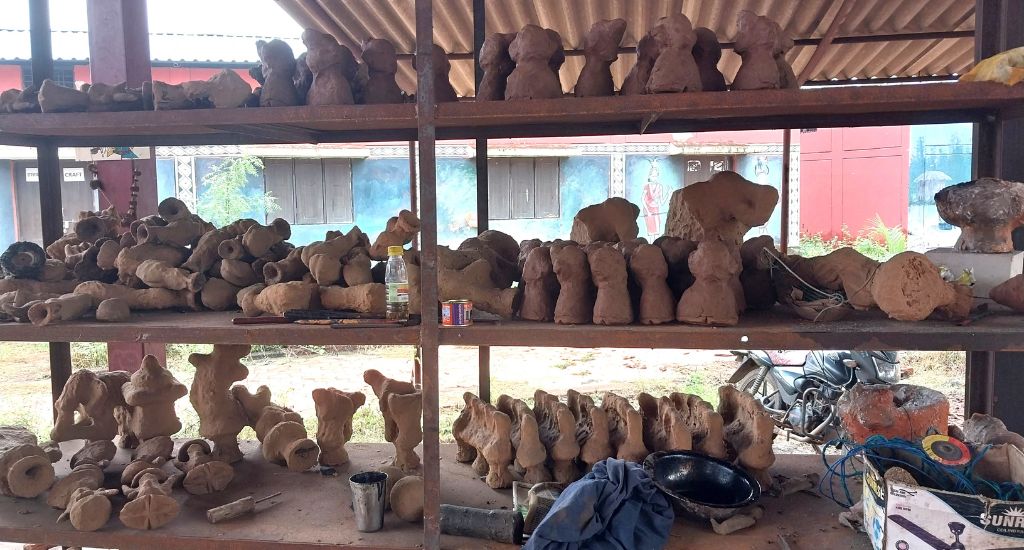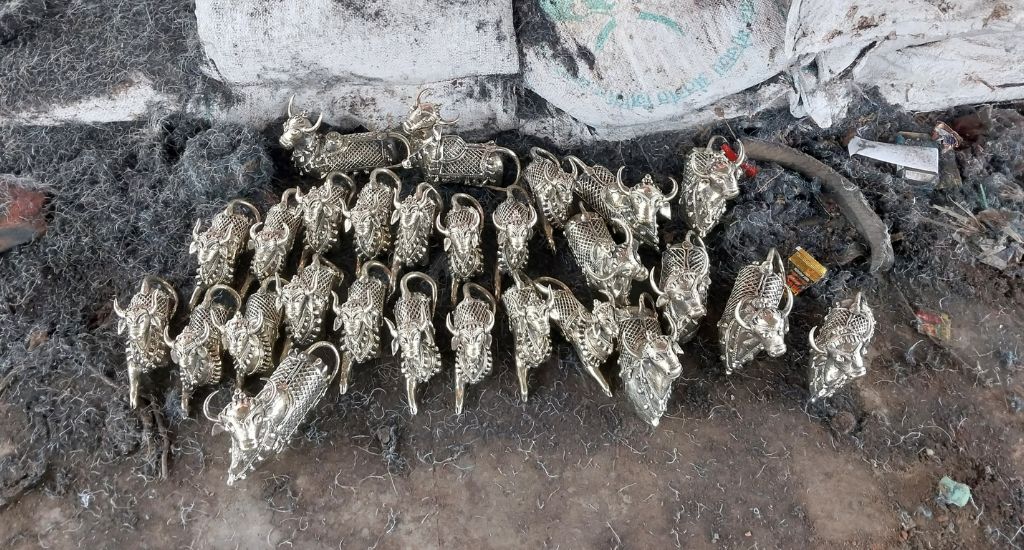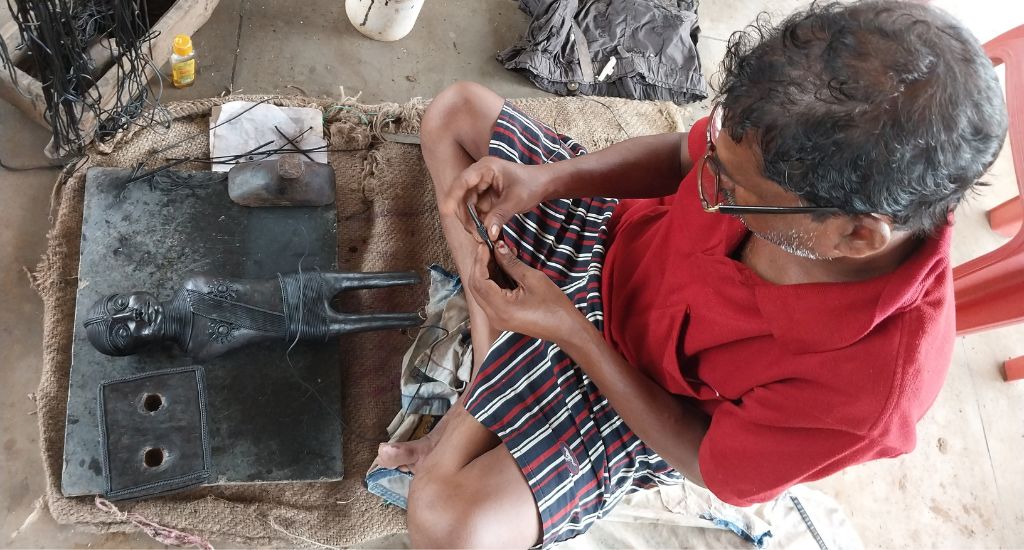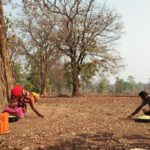Sheltered from the frantic sounds of a city desperate to modernise, Dhokra artisan Bajrang Kuldip sits serenely in his workshop in the expansive craft city of Kondagaon in the Bastar region of Chhattisgarh. He wraps a female figurine with sinuous and noodle-like black wax strips, just as his ancestors did before.
The open workshop, beneath a tin roof supported by sturdy beams, has a smelter, casts, clay, bags filled with charcoal and recycled metal, and shelves packed with neat rows of bell-metal figurines. Here, Kuldip practices an age-old heirloom art form – Dhokra.
For Kuldip, the designated space at craft city, also called Shilpa Nagari, is a refuge and a platform to showcase his intricate creations. “Dhokra has been a traditional profession in my family since the time of my ancestors,” he said. He still makes bell metal items at home.

Commuting daily on his bike a mere 3 km away from home, Kuldip, along with three other artisans, breathes life into this ancient art form. The metal casting technique employed in Dhokra traces its origins back 4,000 years, with artefacts like the “Dancing Girl” from Mohenjo-daro serving as early examples.
The clinking sound of metal on metal echoes through the air as these artisans craft not only statues and figures for home decoration but also fashion jewellery items. “Many tourists visit the place. So, I can directly interact with them and they also see me at work,” Kuldip said.
Also Read: Family of woodcarvers preserves Chhattisgarh’s Muria Ghotul art
Aniruddh Koche, the manager of the retail shop within the craft city, notes the diverse clientele – from Pune, Bangalore, and Hyderabad – who appreciate and purchase these crafted wonders. The price spectrum, ranging from Rs 500 to Rs 1 lakh, reflects the intricate artistry on display. As the shop seeks to showcase utility items like kitchenware, the challenge remains in expanding the market and captivating a wider audience.

Kuldip’s business represents a rare exception in the country, where traditional folk arts and crafts are gradually disappearing with the passing of their creators. With many from the younger generation opting for white-collar jobs, artisans still in business face challenges finding apprentices to carry on the traditions.
City of crafts
Dhokra, like most handicrafts, demands time, labour, and patience. The sculpting process involves a clay core resembling the final cast. A layer of wax, consisting of pure beeswax, resin from the Damara Orientalis tree, and nut oil, is applied to this core. Artisans use the wax mould to carve intricate patterns and details on the sculpture.
Clay is layered over the wax, creating a mould. Molten metal is then poured into this cast, shaping unique and exquisite Dhokra figurines that embody a legacy passed down through generations.
Artisans bewail the lack of customers and the struggle to receive fair prices for their products, making it difficult to cover the costs of labour and raw materials. This market inequality is compelling many craftspeople to transition to jobs in construction or agriculture.
Also Read: A café in Dantewada resuscitates life in a conflict zone

To address these challenges, the craft city was established, providing artisans like Kuldip with the necessary machinery to create and sell their masterpieces directly to patrons. It not only houses workshops but also a handicrafts store and a café run by a women’s self-help group.
“As procuring raw materials is an issue with many artisans, an artisan producer organisation has been formed in Kondagaon to solve the problem and help artisans,” said Ajit Kumar Rana, the district project manager. The union has 99 bell metal artisans and about 36 ironsmiths. This collective effort supports artisans in overcoming financial barriers and facilitates periodic training.
Rana emphasised that the primary challenge lies in selling the finished items. The focus is on creating utility items, such as kitchenware, to tap into local markets and attract more customers.
Problems persist
Despite government aid, Kuldip acknowledged that the craft of Dhokra faces headwinds. “There has been a dip in sales since the (Covid-induced) lockdown, and the youth are not interested in this profession anymore,” he lamented. Annual earnings range from Rs 2 lakh to Rs 2.5 lakh – grossly inadequate to run a family.

Kuldip and his colleagues encounter hurdles in accessing metal, a critical element in their craft. The market demands a hefty price – Rs 450 to Rs 550 for a kg of brass, leading to significant financial outlays. “It is too much hard work. But we have to continue to work and feed our families,” he said.
Also Read: 3Ms herald prosperity in troubled Bastar
Fellow artisan Amin Netam, hailing from a nearby village, brings his own raw materials. Some tools, such as a fan and a blower machine, have been provided to the artisans. However, Netam highlighted that the artisans struggle to receive fair compensation for their work, often selling their products at lower rates.
Online sales pose a challenge too, given the technical barriers faced by many artisans. According to craftsman Phulsingh Sagar, ensuring the website is flawless is crucial. If customers are dissatisfied with the products, they may refrain from placing orders or return them. “This is why many of us are hesitant about the idea of selling online and lack knowledge about the process. If taught, we can give it a try,” he said.

Gaurav Kushwaha, who operates the online site Loka Bazar, underscored the global demand for Dhokra items. However, he pointed out challenges arising from the lack of standardisation in pricing. “Artisans sometimes set prices that are too high, affecting sales. Establishing a fair price is crucial, considering Dhokra’s cultural significance and its role in empowering artisans,” he said.
Also Read: “I’m the lone woman idol maker among 300 artisans”
The lead image at the top shows moulded items left to dry. (Photo by Deepanwita Gita Niyogi)
Deepanwita Gita Niyogi is a journalist based in New Delhi.








